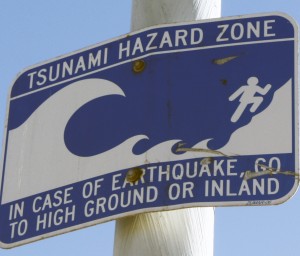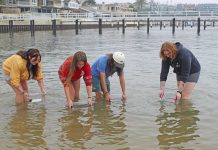Last week, Indy writer Richard Simon provided an overview of tsunamis and what Newport Beach is doing to prepare for such a disaster. This week, Simon covers what to do when a tsunami strikes. To read part one, click here.
At the January 8 meeting of the Newport Beach Harbor Commission, Katie Eing, the emergency services coordinator for Newport Beach, reviewed the city’s tsunami action plan with the commission.
It’s a fairly comprehensive plan, much of which can be viewed in the Emergency Preparedness section of the city’s website at NewportBeachCA.gov.
The plan exists because of the potential for a tsunami caused by earthquakes, especially ones emanating from a subsea landslide zone.
Such a landslide zone exists off Palos Verdes, and Long Beach, and it could cause “the most troubling kind of tsunami,” opined Eing. It would be upon Newport’s shores in minutes.
According to Cal Tech’s Dr. Kate Hutton, “It takes a significant raising or lowering of the ocean floor to cause a tsunami. A possible exception would be a quake that triggered a subsea landslide, which could cause a tsunami. We haven’t seen an offshore tsunami in Southern California since historic times, but our written history is very short from a geologist’s point of view. It could still happen and probably will someday.”

In the 2002, the 33-page “Evaluation of Tsunami Risk to Southern California Coastal Cities” report, funded by FEMA and administered by the Earthquake Engineering Research Institute, noted that “…the deeper water and greater size of (a region called) the Santa Catalina uplift imply that large earthquakes on the Catalina fault would move larger volumes of sea water for greater distances than would large earthquakes along the Palos Verde fault zone.”
Even though Newport has not experienced significant wave effects from recent seismic upheavals – such as the mega-tsunami that virtually eradicated Fukushima, Japan, taking upwards of 16,000 lives – the city is preparing for “worse case scenarios,” Eing said.
“In the last 10 years, we’ve had four tsunami warnings,” she said. Despite the fact that some critics believe Newport is safe from catastrophic tsunamis, Eing said the city focuses on such possibilities because, “We want to save lives.”
In such projections, “50,000 residents would have to evacuate.” If time and conditions permit.
Another less talked about seismic result is something called a seiche, which is caused by passing seismic waves.
“This is usually on a much smaller scale than a tsunami,” Hutton explained, “but it still might cause damage to boats or marina facilities.”
There are more than 10,000 yachts of all sizes docked or moored in Newport Harbor.
A 2002 study by quake researchers stated, “…a large earthquake could create a huge tsunami in Southern California, in timescales of 2,000-5,000 years. When local fault ruptures are factored in, occurrence interval is on the order of 300-500 years.”
The city offers basic, albeit significant tsunami survival advice on its website.
Briefly, they stress:
· When you hear or receive a tsunami warning, assume a dangerous wave is on the way and start heading inland. The city tests the emergency siren system at noon on the first Friday of every month. Some citizens have complained that when the sirens are set off, they don’t hear them. That’s because, according to NBPD Chief Jay Johnson, “they’re tested at just a fraction of their full power.”
· When you feel an earthquake, head for the high ground, for if you do feel strong shaking for eight seconds, the quake is less than 50 miles away – and its tidal wave can reach the coast in less than 15 minutes.
· A tsunami is a series of waves, and waves can strike up to 45 minutes apart. A rising or ebbing fall of coastal waters may indicate a pending tsunami. Grab what you can, leave the danger zone.
· All tsunamis are potentially dangerous, even though they may not damage every coastline they strike. But be assured, over time, all of California’s coastline will be struck.
· Surfing tsunami waves is a recipe for severe injury and possibly death.
· Pay attention to police, firemen and other first responders who are risking their lives on scene to save yours. They may even go house-to-house to alert residents. However, at some point, Chief Johnson said, “The incident commander decides when to pull out police and firemen” in order to save their lives.
“I want the public to know that time is of the essence; it’s critical to pay attention to what officers say and what they tell you to do,” Chief Johnson said. By not obeying commands, nonresponsive citizens will “put my people, and others, at risk.”
Authorities all agree that the best defense against the inevitability of tsunami is education. Learn all you can about this great force. The Boy Scout motto says it best: Be Prepared. And the United States Coast Guard adage, Semper Paratus, bolsters that: Always Ready.
For more information, visit the city’s Disaster Preparedness section of its website at NewportBeachCA.gov.
Contact the writer at Pleasepitchrich@yahoo.com.




